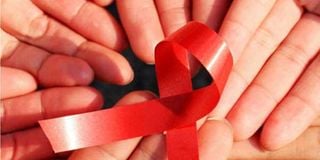HIV in Kenya: Hits, misses and hot air

A red ribbon used in HIV/Aids campaigns.
What you need to know:
- Kenyans are more accepting of those living with HIV. Many now appreciate that one can live a healthy, fulfilling and full life despite being positive. The era of speaking about HIV in hushed tones is long gone and forgotten.
- From the public rollout of low-cost generic anti-retroviral drugs in the early 2000s to providing them free of charge in public hospitals in 2015, massive public education and sensitisation campaigns, Kenya has come a long way in this fight.
“I solemnly pledge to [take] my ARVs daily. To suppress my tiny guest (HIV). To not transmit HIV to anyone else because I am undetectable. And live my life beyond my diagnosis. So help me God.”
This was a prayer tweet by Doreen Moraa Moracha last week.
If you follow Moraa on Twitter or her activity on social media, you already know she is living with HIV. She inspires those living with the virus. Her banner on the platform reads: “There are approximately 1.5 million people living with HIV/Aids in Kenya. I am one of them.”
Moraa happily posts photos of her drugs on the site. The young woman and member of the Youth Taskforce of United Nations Women says she was born with the virus, which is now undetectable. Moraa’s positivity speaks volumes about how far the country has come in terms of attitudes toward HIV. Dreaded and seen as a death sentence two decades ago, the Kenyan population now largely regards HIV like any other disease.
Kenyans are more accepting of those living with HIV. Many now appreciate that one can live a healthy, fulfilling and full life despite being positive. The era of speaking about HIV in hushed tones is long gone and forgotten.
From the public rollout of low-cost generic anti-retroviral (ARV) drugs in the early 2000s to providing them free of charge in public hospitals in 2015, massive public education and sensitisation campaigns, Kenya has come a long way in this fight.
But are we winning the ultimate battle nearly four decades on? Will Kenya attain the goal of zero new infections by 2030 as envisioned under the Kenya HIV Prevention Revolution Roadmap by the Ministry of Health, for instance?
As the world celebrates the World Aids Day on Thursday, Healthy Nation looks back at some of the country’s defining milestones in the fight against the epidemic, changing attitudes toward the disease over the years, the hits and misses and what must be done to bring the numbers further down. What’s more, we have personal stories of HIV/Aids champions, expert views and critical data on the HIV situation in the country.



